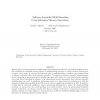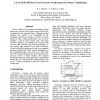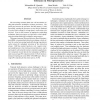38 search results - page 2 / 8 » Increasing memory miss tolerance for SIMD cores |
EGH
2004
Springer
13 years 11 months ago
2004
Springer
The real time 3D graphics becomes one of the attractive applications for 3G wireless terminals although their battery lifetime and memory bandwidth limit the system resources for ...
DATE
2008
IEEE
14 years 1 days ago
2008
IEEE
—The contribution of memory latency to execution time continues to increase, and latency hiding mechanisms become ever more important for efficient processor design. While high-...
HPCA
2000
IEEE
13 years 10 months ago
2000
IEEE
Memorylatency isbecominganincreasingly importantperformance bottleneck, especially in multiprocessors. One technique for tolerating memory latency is multithreading, whereby we sw...
DATE
2007
IEEE
13 years 12 months ago
2007
IEEE
Device scaling in new and future technologies brings along severe increase in the soft error rate of circuits, for combinational and sequential logic. Although potential solutions...
DSN
2005
IEEE
13 years 7 months ago
2005
IEEE
The increasing transient fault rate will necessitate onchip fault tolerance techniques in future processors. The speed gap between the processor and the memory is also increasing,...



